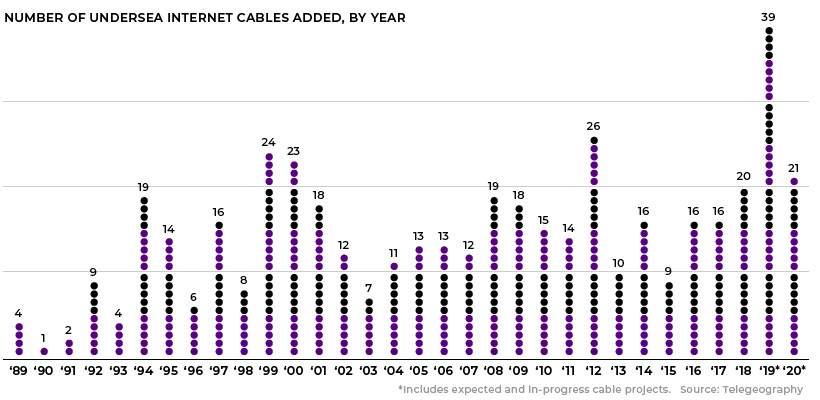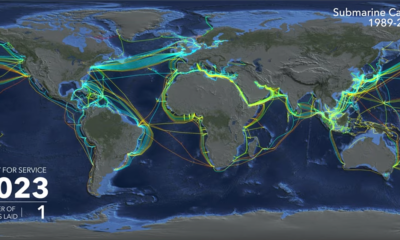This extensive network of cables – which could stretch around the Equator 30 times – is the connective tissue that binds the internet, and thanks to our insatiable appetite for video streaming, it’s growing larger with every passing year. Today’s video, by TED-Ed, explains how fiber optic cables work and introduces the next generation of cables that could drastically increase the speed of data transmission.
A Series of Tubes
The late Senator Ted Stevens drew laughter for describing the internet as a “series of tubes” in 2006, but as it turns out, most of the information moving around the world does, in fact, travel through a series of tubes. Undersea fiber optic tubes, to be exact. The way this system functions is deceptively simple. Light, which is beamed into a fiber optic cable at a shallow angle, ricochets its way along the tube at close to light speed until being converted back into an electrical signal at its destination – generally a data center. To increase bandwidth further, some cables are able to carry multiple wavelengths concurrently. Impressively, this simple method of bouncing light through a tube is what moves 99% of the world’s digital information.
The Glass Superhighway
Since the first undersea fiber optic cable, TAT-8, was constructed by a consortium of companies in 1988, the number of cables snaking across the ocean floor has risen dramatically. In fact, over 100 new cables will have been laid between 2016 and 2020, with a value of nearly $14 billion.
Increasing bandwidth requirements have transformed content providers from customers to cable owners. As a result, tech giants like Google and Facebook are taking a more active role in the expansion of the global fiber optic network. Google alone has at least five cable projects set for completion in 2019.
The Last Mile
If this inefficient use of energy isn’t solved, internet-related activity could comprise a fifth of the world’s power consumption by 2030. Thankfully, a related technology – integrated photonics – could keep the high-definition videos of the future streaming. Although the silicon wires used in integrated photonics do not guide light as effectively as fiber optics, the ultra-thin wires are far more compact. Photonic chips paired with burgeoning terahertz (THz) wireless communications could eventually form the backbone of a 6G network. Short-range THz signals would hitch a ride on silicon wires via tiny photonic chips scattered around population centers. Before this efficient, high-capacity future is realized, researchers must first solve the puzzle of manufacturing photonic devices at scale. Once this method of data transmission hits the mainstream market, it could drastically alter the course of both computing and global energy consumption. on But fast forward to the end of last week, and SVB was shuttered by regulators after a panic-induced bank run. So, how exactly did this happen? We dig in below.
Road to a Bank Run
SVB and its customers generally thrived during the low interest rate era, but as rates rose, SVB found itself more exposed to risk than a typical bank. Even so, at the end of 2022, the bank’s balance sheet showed no cause for alarm.
As well, the bank was viewed positively in a number of places. Most Wall Street analyst ratings were overwhelmingly positive on the bank’s stock, and Forbes had just added the bank to its Financial All-Stars list. Outward signs of trouble emerged on Wednesday, March 8th, when SVB surprised investors with news that the bank needed to raise more than $2 billion to shore up its balance sheet. The reaction from prominent venture capitalists was not positive, with Coatue Management, Union Square Ventures, and Peter Thiel’s Founders Fund moving to limit exposure to the 40-year-old bank. The influence of these firms is believed to have added fuel to the fire, and a bank run ensued. Also influencing decision making was the fact that SVB had the highest percentage of uninsured domestic deposits of all big banks. These totaled nearly $152 billion, or about 97% of all deposits. By the end of the day, customers had tried to withdraw $42 billion in deposits.
What Triggered the SVB Collapse?
While the collapse of SVB took place over the course of 44 hours, its roots trace back to the early pandemic years. In 2021, U.S. venture capital-backed companies raised a record $330 billion—double the amount seen in 2020. At the time, interest rates were at rock-bottom levels to help buoy the economy. Matt Levine sums up the situation well: “When interest rates are low everywhere, a dollar in 20 years is about as good as a dollar today, so a startup whose business model is “we will lose money for a decade building artificial intelligence, and then rake in lots of money in the far future” sounds pretty good. When interest rates are higher, a dollar today is better than a dollar tomorrow, so investors want cash flows. When interest rates were low for a long time, and suddenly become high, all the money that was rushing to your customers is suddenly cut off.” Source: Pitchbook Why is this important? During this time, SVB received billions of dollars from these venture-backed clients. In one year alone, their deposits increased 100%. They took these funds and invested them in longer-term bonds. As a result, this created a dangerous trap as the company expected rates would remain low. During this time, SVB invested in bonds at the top of the market. As interest rates rose higher and bond prices declined, SVB started taking major losses on their long-term bond holdings.
Losses Fueling a Liquidity Crunch
When SVB reported its fourth quarter results in early 2023, Moody’s Investor Service, a credit rating agency took notice. In early March, it said that SVB was at high risk for a downgrade due to its significant unrealized losses. In response, SVB looked to sell $2 billion of its investments at a loss to help boost liquidity for its struggling balance sheet. Soon, more hedge funds and venture investors realized SVB could be on thin ice. Depositors withdrew funds in droves, spurring a liquidity squeeze and prompting California regulators and the FDIC to step in and shut down the bank.
What Happens Now?
While much of SVB’s activity was focused on the tech sector, the bank’s shocking collapse has rattled a financial sector that is already on edge.
The four biggest U.S. banks lost a combined $52 billion the day before the SVB collapse. On Friday, other banking stocks saw double-digit drops, including Signature Bank (-23%), First Republic (-15%), and Silvergate Capital (-11%).
Source: Morningstar Direct. *Represents March 9 data, trading halted on March 10.
When the dust settles, it’s hard to predict the ripple effects that will emerge from this dramatic event. For investors, the Secretary of the Treasury Janet Yellen announced confidence in the banking system remaining resilient, noting that regulators have the proper tools in response to the issue.
But others have seen trouble brewing as far back as 2020 (or earlier) when commercial banking assets were skyrocketing and banks were buying bonds when rates were low.






